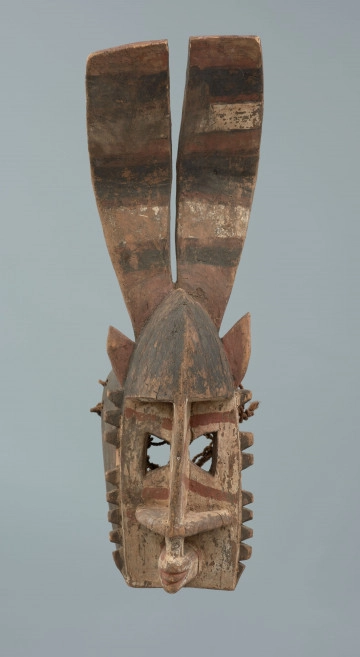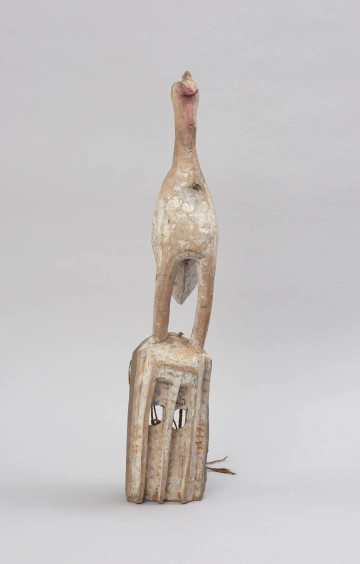
Gomintogo mask
między 1951 — 2000
National Museum in Szczecin
Part of the collection: Collection of Dogonian art
The satimbe mask worn on the face forms a whole with the complete costume. The word satimbe comes from the dogo-so language and literally means a put-on sister (implicitly: on the head). In the Sigi-so ritual language, this mask is called awa danu, meaning a mask made of wood.Like other Dogon masks it is danced during the Dama funeral festivities ending the long period of mourning for the deceased. Depending on the level of initiation, the image of a woman on top of the satimbe mask is interpreted differently. According to one version, it is a representation of the Andumbulu woman responsible for the invention of the fibres that were used to construct the first mask. Another explains it as a woman of the Dogon people who was the first to see the masks dancing in the bush, stole them from Andumbulu and brought them to the village, to the world of the people. Some of the Dogon see in her a representation of Yasigine, the only woman allowed to be in the company of the dancing masks and to participate in the Sigi festival. The first Yasigine was Yasigi, daughter of Amma - the supreme god, creator of the universe, twin sister of Ogo. During the first Sigi she brought beer prepared by women and served it to men. Like her brother, transformed in time into Yurugu, she was disobedient to Amma. During menstruation, instead of submitting to seclusion, she cultivated plants, thus contaminating them with her blood. She was punished by Amma for her disobedience and died while pregnant. The mask was owned by the Awa association, whose members are all circumcised men.
Ewa Prądzyńska
Author / creator
Dimensions
cały obiekt: height: 93 cm, width: 19 cm
Object type
sculpture, mask
Creation time / dating
Creation / finding place
Identification number
Location / status

unknown
między 1951 — 2000
National Museum in Szczecin

unknown
między 1951 — 2000
National Museum in Szczecin

unknown
między 1951 — 1998
National Museum in Szczecin
DISCOVER this TOPIC
National Museum in Szczecin
DISCOVER this PATH
Educational path
0/500

We use cookies to make it easier for you to use our website and for statistical purposes. You can manage cookies by changing the settings of your web browser. More information in the Privacy Policy.
We use cookies to make it easier for you to use our website and for statistical purposes. You can manage cookies by changing the settings of your web browser. More information in the Privacy Policy.
Manage cookies:
This type of cookies is necessary for the website to function. You can change your browser settings to block them, but then the website will not work properly.
WYMAGANE
They are used to measure user engagement and generate statistics about the website to better understand how it is used. If you block this type of cookies, we will not be able to collect information about the use of the website and we will not be able to monitor its performance.